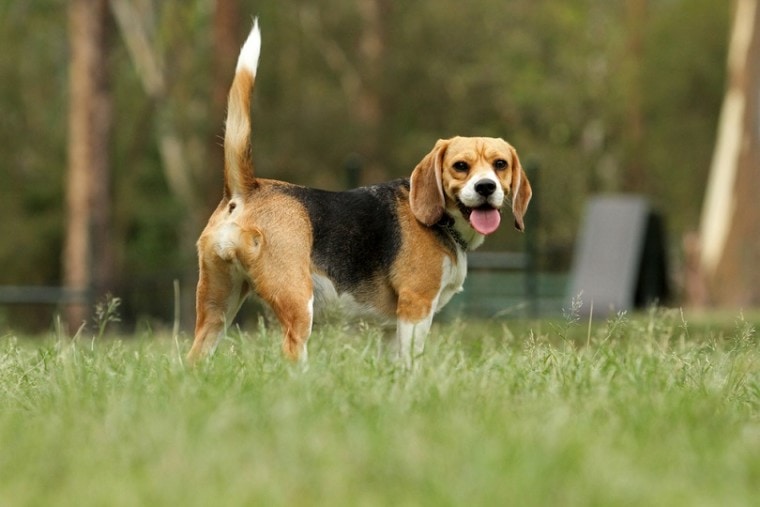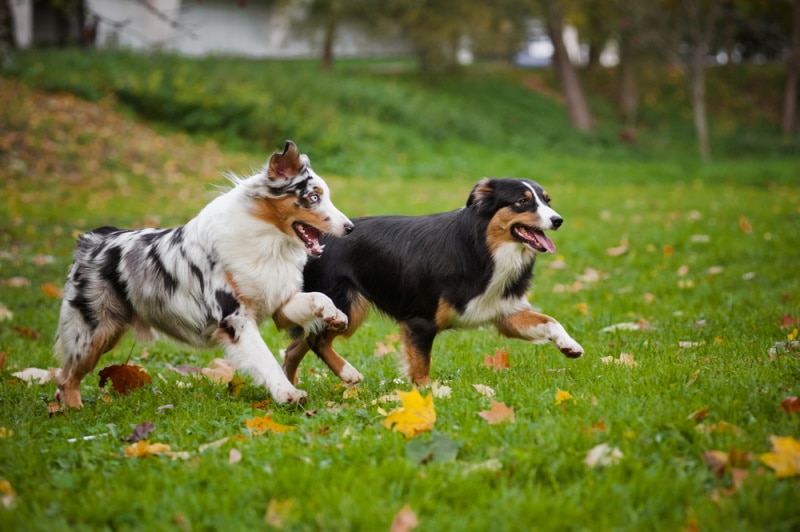
Click Below to Skip Ahead
Beagles are easily one of the most recognizable breeds in the United States. Because of their loving demeanor and small frame, they fit in perfectly in just about any home. Unlike many other breeds, Beagles do just as well in apartment homes as they do in country ones.
They even do great with children and other animals. You might have to work a bit harder to train them, as well as put up with their roaming whenever they catch a whiff of something irresistible, but the effort will certainly be worth it.
Breed Overview
Height:
13 – 15 inches
Weight:
18 – 30 pounds
Lifespan:
10 – 15 years
Colors:
Black, white, tan, red, tri-color; “any hound color”
Suitable for:
Families with children and other pets
Temperament:
Gentle, loving, lazy
With this in mind, Beagles can fit into almost any home, but it’s still up to you whether you select this breed over another one. If you are unsure whether or not a Beagle is right for you, you have come to the right place. In this guide, we’re going to learn all about Beagles.
Everything from puppy price to Beagle fun facts will be discussed in this guide. With our help, you will be able to determine whether or not Beagles are perfect for your home. If we were to bet, you will probably fall in love with Beagles even more after reading this piece.
Beagle Characteristics
Beagle Puppies

Because Beagles are so common, they are much more affordable than other puppies. If you are lucky, you may even be able to find a Beagle at an animal shelter. Beagles frequent animal shelters, but they can be picked out really fast. This means that you have to be lucky to catch them before someone else does. In addition to paying for the puppy itself, you need to pay for other items as well, including getting it spayed or neutered, microchipped, licensed, and other medical needs.
Bringing home a Beagle puppy means having a new loving and affectionate pup in your family. They are great companions due to their calm nature, and create special bonds with families and children. They might not be easy to train, but try socializing your pup as soon as possible so they’re friendlier around other dogs and animals.
Temperament & Intelligence of the Beagle
Beagles are considered one of the most gentle and loving breeds around. They are especially loved because of their loving temperament. They are also intelligent, but they can have a bit of a thick skull because they have been trained to focus on one thing at a time.
Are These Dogs Good for Families? 👪
Beagles are considered one of the best animals for families. They are incredibly gentle and loving to their family and strangers. They do not tend to be aggressive, making them a perfect fit for children. They don’t herd either, making them suitable for young children as well as old ones.
This breed is especially good if you want a dog that is friendly to family and strangers alike. As a whole, this breed is not aggressive or standoffish to any human. This makes them a perfect family dog for vacations or trips to the dog park.
At the same time, Beagles are not very timid either. This means that they will be gentle, loving, and playful with children and people. You don’t have to worry about them hiding or feeling uncomfortable around people.
Still, you do need to socialize the dog early to ensure that it gets along well with all people. Additionally, always supervise playtime between your children and Beagle to ensure a safe playing experience. Teach your child how to play with dogs respectfully.
Does This Breed Get Along with Other Pets?

Beagles tend to get along well with other pets, especially dogs. This breed does not tend to be aggressive, meaning you can easily throw them in the mix with other dogs. In many ways, Beagles get along well with other dogs just like they do other humans.
Because Beagles instinctively chase, though, they might not be ideal for homes with smaller animals. This includes cats and rabbits. However, the breed isn’t naturally aggressive, meaning you can acclimate them to other animal types with a lot of training and diligence. Introducing the Beagle to the other animals sooner rather than later is the best course of action.
Things to Know When Owning a Beagle:
In addition to the Beagle’s calm and gentle demeanor, they’re also loved because of how easy they are to take care of. This breed does not have a lot of exercise and grooming requirements, though they can be a bit of a handful when it comes to training. Plus, they have several health conditions to be aware of beforehand.
Food & Diet Requirements 🦴

Beagles have a very high propensity to gain a lot of weight. They obsess over their food and can get fat really fast. For this reason, you have to be very careful about how much you feed your Beagle to ensure it remains healthy.
It is best to feed your Beagle between ¾ and 1 ½ cups of dog food a day. Tailor the exact amount of food you feed your dog based on its age, activity level, and health needs. Your vet will be able to give more precise recommendations based on your dog’s needs.
When selecting a dog food for your Beagle, make sure it is high-quality. You want the dog food to include a lot of nutrients and vitamins. Ensure that it comes with animal protein and very few carbs or fillers.
Exercise 🐕
Beagles do not need a lot of exercise, but you need to make sure that they get enough playtime. This dog is prone to being lazy, meaning you may need to encourage them to play on their own. Luckily, playtime outside or a walk a day is enough for this dog.
Because Beagles need so little exercise in comparison to other breeds, they are perfectly suited to city or apartment living. Just make sure to take your Beagle on a walk a day to keep it in happy and healthy condition.
Training 🎾

Even though Beagles are caring and gentle, they can be a bit difficult to train. By nature, Beagles are fixated on one thing for the long haul. This can make it difficult to train them when they have their mind set on one thing.
Additionally, Beagles are scent hounds. Because of this fact, they may wander off whenever they smell something particularly enticing. Once again, this can make Beagles difficult to train since they often listen to their nose, not their owners.
With a lot of positive reinforcement and obedience training, though, you can train your Beagle. Luckily, they’re not particularly mischievous or aggressive. They’re just a little hard-headed.
Grooming ✂️
Beagles have a dense double coat that is smooth and resistant terrain. They should be brushed once a week using a medium bristle brush or hound glove. This removes dead hair all while encouraging new hair to grow in its place.
Because Beagles have such dense coats, they do shed. This is especially true in the spring after they shed their winter coats. You shouldn’t have to give them frequent baths, but you will need to brush them more frequently in the winter and clean up during the shedding stage.
You also need to clean out your Beagle’s ears frequently. With a droopy ear, air doesn’t circulate well, making infections very likely. It’s good to check their ears at least every two weeks, if not more frequently. Gently clean out the ear if you notice wax buildup.
Health and Conditions 🏥
One downside of Beagles is that they come with quite a few health conditions. Although many Beagles are healthy, many others experience serious conditions that need to be watched carefully.
Minor Conditions:
Serious Conditions
Male vs Female
Because Beagles are small dogs, the difference in gender is not very noticeable. Males can be taller and heavier, but the size difference is only slight. They have slight personality differences too. Females tend to be much more in need of attention than males. Males like cuddles, but they are more content to be by themselves.
3 Little-Known Facts About the Beagle
1. Not much is known about Beagle history or naming.
Even though Beagles are one of the most popular dogs today, very little is known about their history or their name. It is believed that the Beagle was bred in the 18th century. Interestingly, records about Beagle-like dogs can be found as early as 400 BC, meaning that they may have ancient roots.
It is believed that Beagles descended from Talbot Hounds that were brought to England by William the Conqueror in 1066. From there, early predecessors to Beagles remained popular within England. For example, Elizabeth I had pocket Beagles that seemed to be related to the Beagles we love today. By the 1800s, breeders in England and America separately started breeding modern Beagles.
As for their name, very little is known about where it comes from. It may have been derived from the French word begueule, which means “open throat.” This would refer to the Beagle’s unique vocalizations, which we will talk about shortly.
The name could also come from the old English word beag, which means “small.” This would make sense given that Beagles have been a small breed. Similarly, it could have descended from the French word beugler, which means “to bellow,” or the German word begele, which means “to scold.”
2. Their ears help them smell.
Ears help things hear and noses help things smell, right? Only partially. Crazily enough, it is believed that Beagles’ ears actually help them smell better. Because Beagles have such long ears, often reaching the end of their noses, it allows the scent particles to stay close to the nose. This allows the dog to smell even better since the particles stay around the sniffing area.
3. Beagles have three vocalizations.
When most people think of barking, they don’t realize that there are different types of vocalizations. Beagles are one breed that can actually have three different vocalized sounds. This includes the standard bark, a bay, and a howl. A bay almost sounds like a yodel, and Beagles most often use it when hunting.
Final Thoughts
Beagles are a great breed for just about anyone. Because of their small size, loving nature, and gentle demeanor, they are a favorite among many families around the world. No matter if you live in the country or in the city, you will likely love a Beagle companion.
If you decide to get a Beagle, just remember that they can be a bit difficult to train. Plus, they are susceptible to certain illnesses. If you keep these things in your mind from the beginning, you should be able to monitor your Beagle’s training and health rather carefully.
With everything we have learned in mind, Beagles are easily one of the best breeds you can get. They aren’t that expensive, meaning many families will be able to afford this gentle and fun breed. Not to mention, their personality fits in almost everywhere!
Related Reads:
Featured Image Credit: Ross stevenson, Shutterstock









